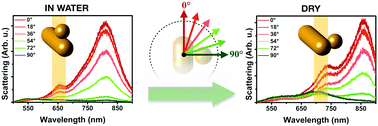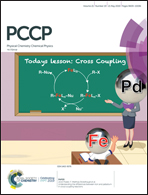Detecting spatial rearrangement of individual gold nanoparticle heterodimers†
Abstract
The self-assembly of properly surface-modified gold nanorods and spherical gold nanoparticles in aqueous medium results in the formation of heterodimers, which show a unique optical scattering spectrum due to the plasmon coupling between the particles. While for the majority of the heterodimers, both particles are located at the substrate level, occasionally, some spherical particles are found to be located on top of the gold nanorods instead of the supporting substrate. Based on optical measurements on such individual heterodimers, it is shown that in contrast to the plain white-light scattering spectrum, the polarization-resolved spectra allow us to distinguish between the cases when the sphere is located on top or at the side of the nanorods. This finding is utilized to investigate the structure of heterodimers upon formation in situ in aqueous medium. It is demonstrated at the individual heterodimer level that both arrangements can be found upon assembly and that the nanosphere originally located on top of the rod right after assembly can indeed rearrange and move to substrate level during drying. The results underline the importance of low-level in situ characterization approaches in the field of nanoparticle self-assembly and can be utilized to assess the impact of different surface ligands, interfacial layers and liquid environments on the drying of nanoparticle-based systems.



 Please wait while we load your content...
Please wait while we load your content...